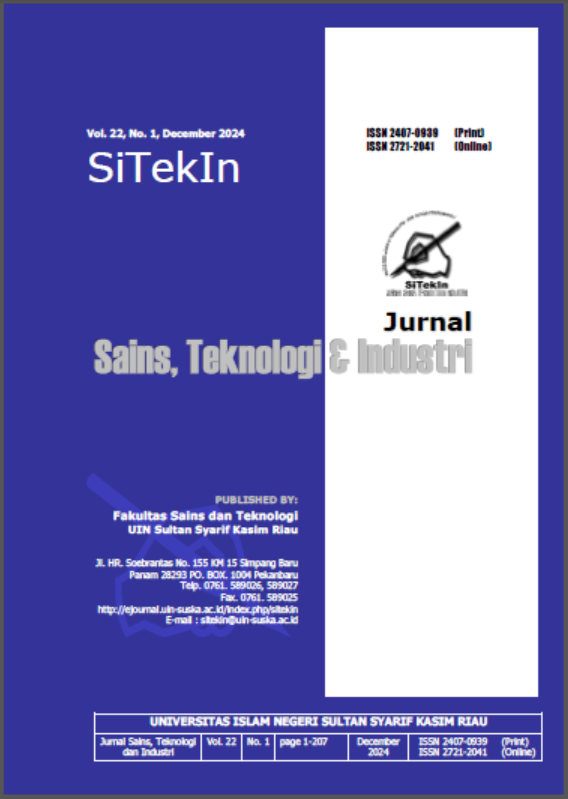Comparative Study of Oil and Gas Products with Manual Formula on a Laboratory Scale in Ensuring Production System Information
DOI:
https://doi.org/10.24014/sitekin.v22i1.33545Abstract
This study explores the enhancement of oil and gas products through laboratory-scale manual formulations to address quality, efficiency, and environmental sustainability challenges. It focuses on biodiesel blends (B10, B30, and B50) and used lubricants treated with citric acid to reduce heavy metal content. The research identifies key functional components in biodiesel that improve combustion efficiency and lower greenhouse gas emissions. Simultaneously, the addition of citric acid in used lubricants aims to reduce metal concentrations, enhancing the potential for recycling and reuse. The results indicate that increasing biodiesel content significantly improves environmental performance and reduces reliance on fossil fuels, though water and sulfur content require strict monitoring to maintain product stability. In used lubricants, the application of citric acid demonstrates varied effectiveness, reducing specific metals like magnesium but increasing others such as calcium and zinc, posing challenges for consistent metal reduction. This study concludes that combining manual formulations and chemical treatments provides valuable insights into optimizing oil and gas products. It emphasizes the need for careful control of component levels to meet quality standards and environmental regulations. The findings suggest that refining the application of citric acid could further enhance its effectiveness in minimizing harmful metal concentrations, supporting sustainable and eco-friendly practices in the oil and gas sector.
References
A. Guntarti and S. R. Prativi, “Application method of Fourier Transform Infrared (FTIR) combined with chemometrics for analysis of rat meat (Rattus Diardi) in meatballs beef,” Pharmaciana, vol. 7, no. 2, p. 133, Nov. 2017, doi: 10.12928/pharmaciana.v7i2.4247.
P. Inc, “Analysis of Trace Elements in Fertilizer with Avio 200 ICP-OES.”
S. R. Khan, B. Sharma, P. A. Chawla, and R. Bhatia, “Inductively Coupled Plasma Optical Emission Spectrometry (ICP-OES): a Powerful Analytical Technique for Elemental Analysis,” 2022. doi: 10.1007/s12161-021-02148-4.
F. Irmasari, “Kadar Toluen di Udara Lingkungan Kerja Berkorelasi terhadap Kadar Asam Hipurat Urine pada Pekerja Percetakan di Rungkut Surabaya,” Jurnal Kesehatan Lingkungan, vol. 10, no. 2018, 2018.
S. Thain, “IR Spectroscopy and FTIR Spectroscopy: How an FTIR Spectrometer Works and FTIR Analysis,” Technology Networks Analysis & Separations, 2022.
S. S. Wirawan, M. D. Solikhah, H. Setiapraja, and A. Sugiyono, “Biodiesel implementation in Indonesia: Experiences and future perspectives,” 2024. doi: 10.1016/j.rser.2023.113911.
K. Fatama Khan, “Application, principle and operation of ICP-OES in pharmaceutical analysis,” ~ 281 ~ The Pharma Innovation Journal, vol. 8, no. 11, 2019.
P. N. Alam, “Aplikasi Proses Pengkelatan untuk Peningkatan Mutu Minyak Nilam Aceh,” Jurnal Rekayasa Kimia & Lingkungan, vol. 6, no. 2, 2007.
A. Prastika Anggraini, E. Megawati, D. Ariyani, P. Studi Pengolahan Minyak dan Gas, S. Tinggi Teknologi Migas, and K. Timur, “ANALISIS KANDUNGAN FATY ACID METIL ESTER (FAME) PADA BIOSOLAR B30 DENGAN METODE FOURIER TRANSFORM INFRARED (FTIR) STUDI KASUS LABORATORIUM PT. X,” Jurnal Teknosains Kodepena |, vol. 04, pp. 7–11, 2024.
A. Zakiy et al., “Analisis Kandungan Logam Berat Pada Air Sungai Kaligarang Menggunakan ICP-OES (Inductively Coupled Plasma-Optical Emission Spectrometry)”.
Downloads
Published
Issue
Section
License
This work is licensed under a Creative Commons Attribution-ShareAlike 4.0 International License
Copyright Notice
An author who publishes in the SITEKIN Journal agrees to the following terms:
- Author retains the copyright and grants the journal the right of first publication of the work simultaneously licensed under the Creative Commons Attribution-ShareAlike 4.0 License that allows others to share the work with an acknowledgement of the work's authorship and initial publication in this journal
- Author is able to enter into separate, additional contractual arrangements for the non-exclusive distribution of the journal's published version of the work (e.g., post it to an institutional repository or publish it in a book) with the acknowledgement of its initial publication in this journal.
- Author is permitted and encouraged to post his/her work online (e.g., in institutional repositories or on their website) prior to and during the submission process, as it can lead to productive exchanges, as well as earlier and greater citation of the published work (See The Effect of Open Access).
Read more about the Creative Commons Attribution-ShareAlike 4.0 Licence here: https://creativecommons.org/licenses/by-sa/4.0/.

